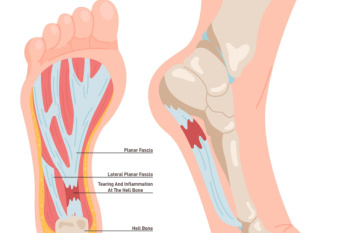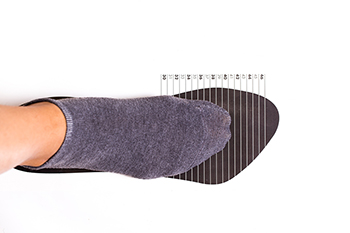Items filtered by date: August 2025
Ankle Fracture? Don’t Wait for Treatment
Twists and Sprains on the Trail

Trail running exposes the feet and ankles to forces and hazards not found on smooth pavement. Uneven ground, hidden roots, and shifting rocks can quickly lead to rolled ankles, strained ligaments, or stress fractures. The constant changes in slope and surface demand rapid adjustments in foot placement, increasing the chance of missteps that overstretch tendons or tear soft tissue. Repeated downhill impact can bruise the heel or inflame structures like the plantar fascia. In some cases, sudden landings on unstable surfaces cause foot bone injuries that require weeks of recovery. Trail conditions such as mud, loose gravel, and water crossings can make slips more likely, leading to sharp impacts or twisting falls. Because these injuries can escalate and lead to long-term complications if ignored, it is suggested that you visit a podiatrist for any lingering pain, swelling, or difficulty bearing weight after a run.
Ankle and foot injuries are common among athletes and in many sports. They can be caused by several problems and may be potentially serious. If you are feeling pain or think you were injured in a sporting event or when exercising, consult with one of our podiatrists from Florida. Our doctors will assess your condition and provide you with quality foot and ankle treatment.
Common Injuries
The most common injuries that occur in sporting activities include:
- Achilles Tendonitis
- Achilles Tendon Rupture
- Ankle Sprains
- Broken Foot
- Plantar Fasciitis
- Stress Fractures
- Turf Toe
Symptoms
Symptoms vary depending upon the injury and in some cases, there may be no symptoms at all. However, in most cases, some form of symptom is experienced. Pain, aching, burning, bruising, tenderness, tightness or stiffness, sensation loss, difficulty moving, and swelling are the most common symptoms.
Treatment
Just as symptoms vary depending upon the injury, so do treatment options. A common treatment method is known as the RICE method. This method involves rest, applying ice, compression and elevating the afflicted foot or ankle. If the injury appears to be more serious, surgery might be required, such as arthroscopic or reconstructive surgery. Lastly, rehabilitation or therapy might be needed to gain full functionality in the afflicted area. Any discomfort experienced by an athlete must be evaluated by a licensed, reputable medical professional.
If you have any questions please contact our offices located in North Miami, and Pembroke Pines, FL . We offer the newest diagnostic and treatment technologies for all your foot and ankle needs.
Risk Factors and Causes of a Bruised Heel Bone

A bruised heel bone can occur suddenly due to a fall, jumping, or stepping on a sharp object. This type of injury also can develop gradually from repeated impact on hard surfaces or stiff shoes. Risk factors for a bruised heel include advancing age, obesity, and endurance running. A history of cortisone shots, conditions like diabetes or rheumatoid arthritis, and previous heel injuries or surgery are other possibilities. Healing time for a bruised heel bone depends on the severity of the injury and level of activity. If the injury is sudden and severe or if pain persists, it is important to consult a podiatrist, as they may recommend imaging to rule out fractures or soft tissue damage. This type of doctor can prescribe custom orthotics or, in some cases, surgery. If you have symptoms of a bruised heel bone, it is suggested that you schedule an appointment with a podiatrist for appropriate treatment options.
Many people suffer from bouts of heel pain. For more information, contact one of our podiatrists of Florida. Our doctors can provide the care you need to keep you pain-free and on your feet.
Causes of Heel Pain
Heel pain is often associated with plantar fasciitis. The plantar fascia is a band of tissues that extends along the bottom of the foot. A rip or tear in this ligament can cause inflammation of the tissue.
Achilles tendonitis is another cause of heel pain. Inflammation of the Achilles tendon will cause pain from fractures and muscle tearing. Lack of flexibility is also another symptom.
Heel spurs are another cause of pain. When the tissues of the plantar fascia undergo a great deal of stress, it can lead to ligament separation from the heel bone, causing heel spurs.
Why Might Heel Pain Occur?
- Wearing ill-fitting shoes
- Wearing non-supportive shoes
- Weight change
- Excessive running
Treatments
Heel pain should be treated as soon as possible for immediate results. Keeping your feet in a stress-free environment will help. If you suffer from Achilles tendonitis or plantar fasciitis, applying ice will reduce the swelling. Stretching before an exercise like running will help the muscles. Using all these tips will help make heel pain a condition of the past.
If you have any questions, please feel free to contact our offices located in North Miami, and Pembroke Pines, FL . We offer the newest diagnostic and treatment technologies for all your foot care needs.
Plantar Fasciitis Is a Common Cause of Heel Pain

Plantar fasciitis is the inflammation of the plantar fascia, a thick band of tissue that runs along the bottom of the foot, connecting the heel to the toes. It is often caused by repetitive strain, prolonged standing, or wearing unsupportive footwear. Risk factors include high arches, flat feet, obesity, and increased activity levels. Symptoms typically include sharp heel pain, especially during the first steps in the morning or after rest. A podiatrist can diagnose the condition, recommend stretching exercises, prescribe custom orthotics, and suggest footwear changes. If you are experiencing heel pain that interferes with daily activities, it is suggested that you consult a podiatrist for a diagnosis and treatment.
Plantar fasciitis can be very painful and inconvenient. If you are experiencing heel pain or symptoms of plantar fasciitis, contact one of our podiatrists from Florida. Our doctors can provide the care you need to keep you pain-free and on your feet.
What Is Plantar Fasciitis?
Plantar fasciitis is the inflammation of the thick band of tissue that runs along the bottom of your foot, known as the plantar fascia, and causes mild to severe heel pain.
What Causes Plantar Fasciitis?
- Excessive running
- Non-supportive shoes
- Overpronation
- Repeated stretching and tearing of the plantar fascia
How Can It Be Treated?
- Conservative measures – anti-inflammatories, ice packs, stretching exercises, physical therapy, orthotic devices
- Shockwave therapy – sound waves are sent to the affected area to facilitate healing and are usually used for chronic cases of plantar fasciitis
- Surgery – usually only used as a last resort when all else fails. The plantar fascia can be surgically detached from the heel
While very treatable, plantar fasciitis is definitely not something that should be ignored. Especially in severe cases, speaking to your doctor right away is highly recommended to avoid complications and severe heel pain. Your podiatrist can work with you to provide the appropriate treatment options tailored to your condition.
If you have any questions, please feel free to contact our offices located in North Miami, and Pembroke Pines, FL . We offer the newest diagnostic and treatment technologies for all your foot care needs.
Foot Problems From Wearing the Wrong Size Shoes

Knowing your correct shoe size is important for foot comfort and health. To measure at home, place your foot on a piece of paper, mark the tip of the longest toe and the end of the heel, then measure the length. For width, measure across the widest part of your foot. Wearing shoes that are too tight or too loose can lead to blisters, bunions, hammertoes, and arch pain. A podiatrist can evaluate your foot shape, identify pressure points, and recommend proper footwear. If you have developed foot pain from wearing the wrong shoe size, it is suggested that you consult a podiatrist who can help guide you toward the right fit and prevent future foot problems.
Getting the right shoe size is an important part of proper foot health. Seek the assistance of one of our podiatrists from Florida. Our doctors will provide the care you need to keep you pain-free and on your feet.
Getting the Right Shoe Size
There are many people who wear shoes that are the incorrect size, negatively affecting their feet and posture. Selecting the right shoes is not a difficult process, so long as you keep several things in mind when it comes to choosing the right pair.
- When visiting the shoe store, use the tools available to measure your foot.
- Be sure there is ‘wiggle room’. There should be about an inch between your toes and the tip of your shoes.
- Do not always assume you are the same size, as manufacturers run differently.
- Purchase shoes later in the day, as your feet swell as the day progresses.
- If a shoe is not comfortable, it is not suitable. Most shoes can’t be ‘broken in’, and comfort should be the ultimate goal when it comes to choosing the right pair of shoes
As our feet hold our body weight and keep us moving, it is important to treat them right. Picking the right pair of shoes can provide your feet comfort and mobility without pain.
If you have any questions, please feel free to contact our offices located in North Miami, and Pembroke Pines, FL . We offer the newest diagnostic and treatment technologies for all your foot care needs.

